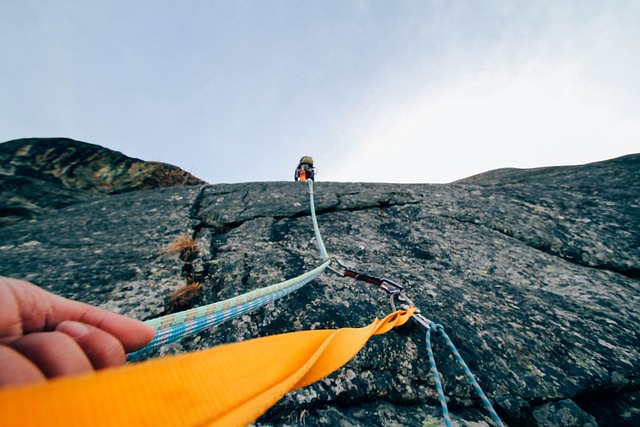
Whether you're taking up climbing for the first time, or you're already a seasoned climber who's looking to learn more about fall theory, this handy guide will answer the following questions:
- What is fall factor?
- Why is fall factor important?
- How do you calculate fall factor?
Disclaimer: Before we go any further, we'd just like to make it clear that you should always set up your climbing rig with the help of a professional/qualified climber. The examples of fall factors that we describe here are just that - examples - and should be used in a supplementary way when you're planning a climb. It is important that you've read and understood the equations outlined in this article carefully before you consider applying this theory to a real-life scenario.
What is fall factor?
Fall factor is a number between 0 and 2 that measures the severity of a fall. Fall factor calculations are based on the length of rope available to take the impact of a fall and the distance the person will fall in the event of an accident.
The smallest possible fall factor is 0, which occurs when a climber falls while attached to a rope with no slack.
When climbing from the ground up a sheer face (for example a rock climbing wall or cliff), the maximum possible fall factor is 1. Any fall with a fall factor greater than 1 would mean that the climber hit the ground.
In some scenarios - for example, when a climber starts on an exposed ledge and climbs upwards from there - the fall factor can be as high as 2.
How to calculate fall factor
To calculate a fall factor (F), you first need to know two things. The distance (D) that the climber falls before the rope catches them and the length (L) of rope available to catch them.

As the equation above demonstrates, you calculate the fall factor (F), by dividing the distance the person falls (D) by the length of rope available to catch them (L).
When you calculate the fall factor of a climbing scenario, you can accurately determine the violence of the forces that will be applied not only to the climber but to the climbing equipment they are wearing. This can help you ascertain whether the equipment you have for a particular job is suitable or not.
Fall factor examples
Let's have a look at some examples of different fall factors so you can see this theory in action!
Fall factor of 0
Going back to our previous example where the smallest possible fall factor could be 0. How is this possible? Well, a fall factor of 0 occurs when a person falls while attached to a rope with no slack available.
This means the distance (D) at which the person will fall before their rope catches them is 0. In this scenario, the fall factor will always be 0, because regardless of the length of the rope, the distance they fall (0 metres) divided by the length of the rope (for example 10 metres) will equal 0.
Fall factor of 0.5
If a person falls a distance of 4 metres while attached to an 8-metre-long rope, then the fall factor is 0.5. A fall factor of 0.5 on a dynamic climbing rope with some stretch in it, will generate much less force on the person and the equipment than the same fall on a low-stretch rope.
Falls with a fall factor of 0.5 are generally low impact, unless (of course) your rope is longer than the distance before you hit the ground. If you fall a distance of 4 metres on an 8-metre rope, but the ground was only 6 metres away at the point you fall - then you're going to have some pretty serious injuries on your hands. Always choose a climbing rope that is shorter than your distance from the ground!
Fall factor of 1
A fall factor of 1 occurs when a person climbs up the full length of rope to the anchor point and then falls. For example, a fall of 10 metres on a 10-metre-long rope. As the fall factor increases, the potential force that's exerted on the person and the climbing equipment increases too.
The highest level of risk occurs when there is a lot of slack in the rope and the climber is approaching the anchor point.
Fall factor of 2
The absolute maximum fall factor for a climber or rescuer is a fall factor of 2. This is when a person has climbed past the anchor point, and fallen twice the length of the rope he or she is attached to. Regardless of whether a climber climbs 2 metres on 1 metre of rope, or 20 metres on 10 metres of rope, the likelihood of an injury when a fall occurs with a fall factor of 2 is incredibly high.
So, now you know all about fall factors, it's time to get kitted up for your next climb. Here at Safety Harness Direct, we offer a wide range of climbing equipment, including safety harnesses, anchor points, lanyards and more.
Click Here to Shop >

